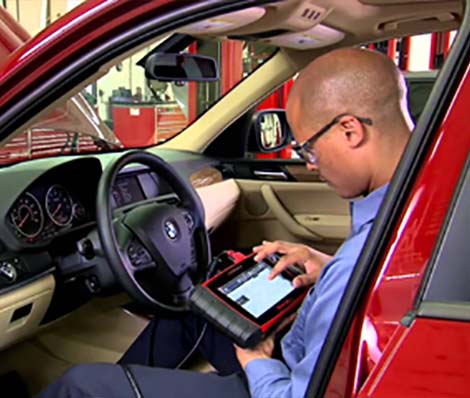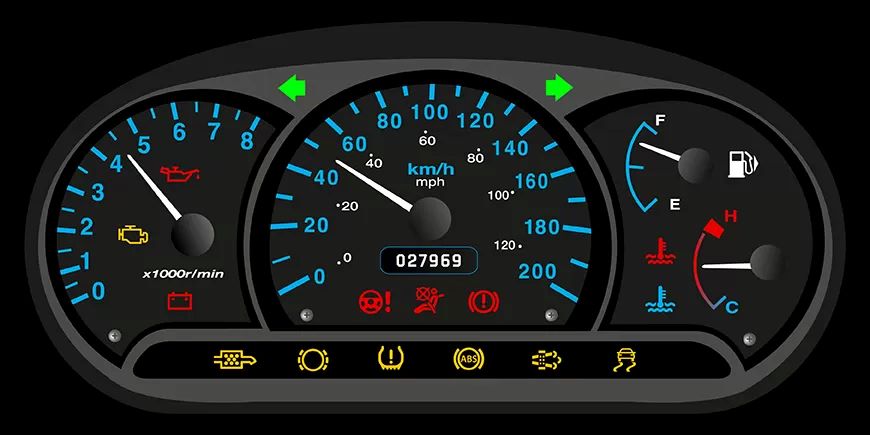

The Engine Tune-up is an essential part of your engine running. Regular Engine Tune-up maintenance is an important formula for fuel-efficient and saving. Infrequent tune-ups can increase fuel consumption up to 50% percent leading to poor fuel mileage, rough running and difficult starting.
For better performance and smooth starting, it is essential that your engine is maintained regularly. The tune-up is a series of maintenance steps aimed at restoring engine optimal operation including, among other things, replacing air filter, spark plugs, cleaning the injectors, hrottle body and fuel filter replacement.
WARNING SIGNS:
- Engine Fault Warning Light (Check Engine).
- Difficult Engine Starting
- Unstable Engine Idling.
- Fuel Consumption.
- Unpleasant Smell From Exhaust.
SERVICE TIPS:
Most manufacturers recommend an engine tune-up check every 36 months or 60 thousand kilometers (38,000 miles).
When one of the malfunction lights illuminates on your vehicle's dashboard. It is important not to ignore this as it can indicate various potential problems and could lead to damage to vehicle components . Act quickly to diagnose and resolve the problem as soon as possible.
The lights on a car's dashboard may vary depending on vehicle make and model. However, here is a list most common dashboard warning lights explained:

SERVICE DUE LIGHTThe “Service Due Light”i s a general indication that your vehicle requires regular maintenance or a scheduled service according to the manufacturer's recommended maintenance schedule. WINDSHIELD WASHER LIGHTWhen the windshield washer light illuminates on your vehicle's dashboard, it usually indicates that the windshield washer fluid is low and it is time to refill it. (TPMS) TIRES LIGHTWhen the tire pressure monitoring light (TPMS) illuminates on your vehicle's dashboard, it usually signals a tire pressure problem, a flat tire, or a faulty sensor. ENGINE OIL LIGHTIf the engine oil light comes on, it is important to safely stop the vehicle immediately and check the oil level using the oil dipstick. Ignoring the engine oil warning light can result in costly engine damage and even complete engine failure. ENGINE TEMPERATURE LIGHTWhen the engine temperature light illuminates on your car's dashboard, it usually signals an overheating engine problem. Engine temperature is a critical aspect of the proper operation of your vehicle, and overheating can lead to serious engine damage if not treated promptly. BATTERY LIGHTThe battery light on your car's dashboard is a crucial indicator that usually signals problems with the battery charging system. When this light comes on it is important not to ignore, it can indicate several potential problems: BATTERY FAILURE: CHARGING SYSTEM FAILURE: DRIVE BELTS: GENERAL ELECTRICAL PROBLEMS: SUSPENSION LIGHTWhen you have a problem with your air suspension (AirMatic), it can lead to a variety of symptoms and complications. If the message (DRIVE TO WORKSHOP) appears on your dashboard. It is important not to ignore this message, this indicates that there is a potential mechanical, electronic or pneumatic problem with the suspension of your vehicle. PROXIMITY SENSORSome vehicles are equipped with driver assistance systems that use proximity sensors to monitor nearby vehicles and help the driver maintain a safe distance. These systems can also be used to alert the driver in the event of an unsafe lane change or risk of collision. It is important not to ignore warning lights related to safety systems can compromise your vehicle's safety features and increase the risk of an accident. |
ENGINE LIGHTWhen the "Check Engine" or "Service Engine Soon" light illuminates on your vehicle's dashboard, it indicates that there is a problem with the management system of the motor. Here are some common reasons why the check engine light may come ON: IGNITION SYSTEM PROBLEMS: FUEL SYSTEM FAILURE: ENGINE CONTROL SYSTEM PROBLEMS: EMISSIONS ISSUES: TRANSMISSION PROBLEMS: If the message (DRIVE TO WORKSHOP) appears on your dashboard. It is important not to ignore this message, this indicates that there is a potential mechanical or electronic problem with your vehicle's transmission. BRAKE LIGHTThe brake warning light is a light on the dashboard that illuminates to indicate a potential problem with your vehicle's brake system. When the brake warning light comes on, it is important not to ignore this signal, it can mean several things, including: BRAKE FLUID: BRAKE PADS & DISCS: BRAKE SYSTEM PROBLEMS: (ABS) BRAKE LIGHTWhen the anti-lock brake (ABS) light illuminates on your car's dashboard, it usually signals a problem with the anti-lock brake system. TRACTION CONTROL LIGHTIf the Traction and Stability Control light stays on continuously or flashes while you are driving: this may indicate a malfunction in one of the control systems (ESC) or (TCS). AIRBAG LIGHTThe airbag light may illuminate due to a problem detected with one of your vehicle's airbags. This could be caused by a faulty sensor, loose connector, electrical problem, or a fault in the airbag deployment system. |
Schedule A Quick Appointment (450) 681-1414
Air Intake System Inspection: Air filter, intake manifold, intake valves, idle air control (IAC) valve, mass air flow meter (MAF) and intake tubes.
Fuel System Inspection Operation of the throttle valve, pump, condition of the fuel filter, injectors and fuel lines.
Ignition System Inspection: Spark plugs, ignition cables, distributor cap, rotor, ignition coils, oxygen sensor and timing belt.
Air Intake System Maintenance: Replacing air filter, intake valves and cleaning the air intake system.
Fuel System Maintenance: Replacing fuel filter, cleaning injectors and throttle valve.
Ignition System Maintenance: Replacing spark plugs, ignition cables, distributor cap, rotor, ignition coils and oxygen sensor.
Air Intake System Repair: Air leak at intake manifold, replacing intake valves, idle air control (IAC) valve, mass flow meter air (MAF) and intake tubes.
Fuel System Repair: Replacing throttle valve, fuel pump, injectors and fuel lines.
Ignition System Repair: Replacing spark plugs, ignition cables, distributor cap, rotor, ignition coils, oxygen sensor and timing belt.
Check-Engine Warnings Lights: Scanner analysis to determine the origin of the problem, poor acceleration, engine hesitation, irregular idling, engine starts with difficulty or does not start.
Vehicle road test before delivery, using several simulations and driving maneuvers to test engine and transmission performance at acceleration and at idle to ensure the systems proper functioning and that no fault lights ON.
When considering an engine tune-up for off-road driving you will likely want to optimize your vehicle's power, torque, and responsiveness while taking into account the specific demands of off-road driving. Here are some points to consider:
Power & Torque:
- Consider modifications such as high-performance air filters, upgraded exhausts, and electronic engine management adjustments to increase horsepower and torque, which can be helpful in overcoming obstacles and difficult terrain.
Engine Responsiveness:
- Opt for throttle and engine response settings that provide better responsiveness at low revs, which can be crucial for controlling the vehicle over rough and unpredictable terrain.
Cooling:
- Make sure the engine cooling system is adequate to handle the added stresses of off-road driving. This may include installing larger radiators or upgraded cooling systems.
Sustainability:
- Reinforce critical engine components for off-road use, such as radiators, oil pan guards, underbody guards, and air intake system guards, to minimize damage. risk of damage.
Filtration:
- Opt for high-quality air filters and filtration systems that can protect the engine from dust, dirt and debris encountered while driving off-road.
Regular Maintenance:
- Be sure to follow a regular maintenance schedule for your engine, including frequent oil changes, replacing air and oil filters, and regularly inspecting components for signs of potential problems.
Field Testing & Adjustment:
- After making engine tune-up modifications, test them in different types of terrain to ensure they meet your specific off-road driving needs. Be prepared to adjust settings accordingly.
Environmental Considerations:
- Make sure any modifications to your engine meet local emissions and environmental regulations to minimize the environmental impact of your vehicle.
- By performing an engine tune-up suitable for off-road drivingyou can improve the performance and reliability of your vehicle while ensuring its durability in harsh conditions. Be sure to consider the specific needs of your vehicle and driving style, and consider consulting an auto service professional for advice specific to your situation.
- Washing the underside of the chassis,the importance of washing the underside of your vehicle with a high-pressure jet to remove salt, sludge, leaves and stones.
When looking for service tips for your vehicle's tune-up and diagnostics, here are some important recommendations to consider:
Regular Maintenance:
- Schedule regular maintenance appointments for your vehicle, according to the manufacturer's recommendations. This may include oil changes, filter replacements, general inspections and other preventative maintenance services.
Early Diagnosis:
- If you notice any unusual symptoms such as noises, vibrations, leaks, or poor performance, have your vehicle diagnosed as soon as possible. Early diagnosis can help avoid major and costly problems in the future.
Diagnostic Equipment Use:
- Use advanced diagnostic equipment to accurately identify possible problems with your vehicle. OBD-II scanners and other diagnostic tools can provide accurate fault codes to aid in the diagnostic process.
Visual Inspection:
- Perform regular visual inspections of your vehicle for signs of damage or wear. This may include inspection of engine components, transmission system, suspension, brakes, steering, on-board electronics, etc.
Follow Manufacturer's Recommendations:
- Follow the manufacturer's maintenance and tune-up recommendations for your vehicle. This may include replacement intervals for spark plugs, air and fuel filters, transmission and coolant fluids, and other recommended services.
Consult Qualified Professionals:
- If you are unsure about what repairs or adjustments need to be made to your vehicle, consult a qualified automotive service professional. They can perform accurate diagnostics and recommend necessary repairs to keep your vehicle running smoothly.
Be Proactive:
- Don't wait for problems to develop before taking action. Be proactive in maintaining and repairing your vehicle to avoid unplanned breakdowns and extend its lifespan.
Complete Automobile & Truck Services.
Automotive repairs, tune-ups and diagnostics are essential aspects of maintaining your vehicle to ensure its proper operation and safety. Here are some general tips for repairs, tuning and diagnostics:
Accurate diagnosis:
- Before carrying out any repairs or tune-up, we will carry out a precise diagnosis to identify the specific problems with your vehicle.
Use Appropriate Service Manuals & Tools:
- We use the appropriate tools and equipment to perform repairs and diagnostics plus we refer to service manuals and repair guides specific to your vehicle for detailed instructions on the diagnostic and repair procedures recommended by the manufacturer.
Issues Prioritization:
- We identify the most urgent or critical issues and begin repairing them as a priority. This can prevent minor problems from becoming more serious in the future.
Repair Root Cause:
- When diagnosing and repairing, aim to identify and resolve the root causes of problems rather than simply treating symptoms. This can prevent problems from recurring in the future.
- Once repairs are completed, our technicians will perform a road test and additional check to ensure the problem has been resolved and that no malfunction warning lights come ON.